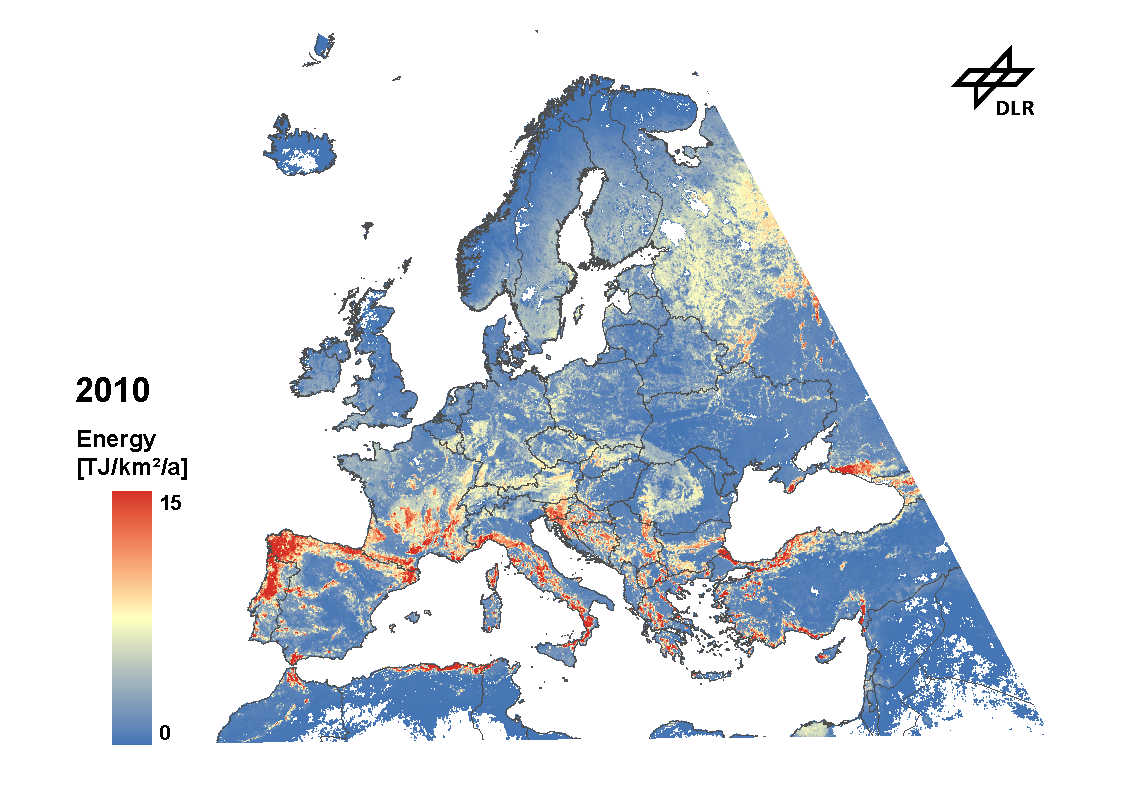
Bio-Energy
Bio-energy potential
Description:
The bio-energy product for Europe is calculated using simulations of the Biosphere Energy Transfer Hydrology (BETHY/DLR) vegetation model (Knorr, 1997, Wiβkirchen, 2005). The spatial resolution is variable and can currently be set up to ca. 300m x 300m.
Annual bio-energy maps are available on request for:
- Agriculture, forest and grassland
- Temporal coverage: 2000 - today (Europe and northern Africa)
- Temporal resolution: 1 year
- Spatial resolution: ~1km
- Spatial coverage: Europe, northern Africa, central Asia; further areas on request
Product example:

Fig. 1: Theoretic-technical energy potential for agriculture, forest and grassland for Europe, 2010.
Methodology:
The availability of biomass is influenced by various natural and anthropogenic factors, such as regional variations in climatic conditions and management practices. The annual biomass increase is calculated by using data from the vegetation model BETHY/DLR (Tum and Günther, 2011; Tum et al., 2011). BETHY/DLR calculates Gross- and Net-Primary-Productivity (GPP and NPP) on a daily basis, which is aggregated to annual sums. The conversion to biomass is done by applying relations of e.g. the corn-to-straw and above-to-below ground biomass and taking into account local management information. With this additional data, fractions of potential energy sources (straw/yield content, grain, tuber, oil-plant, etc. fraction per grid cell) can be calculated. In a second step the fractionized biomass increase is converted to energy units by using species specific lower heating values.
Data access:
A free example data set covering Europe based on the year 2010 can be accessed via e-mail request. More data and time series can be processed on request (see contact section). Available products are:
- Digital GIS maps
- Digital maps
– Digital maps of annual sums
– Digital maps of long term averages
– Digital maps of bio-energy variability
– Colored jpeg images
Contact:
Literature:
Knorr W., 1997. Satellite Remote Sensing and Modelling of the Global CO2 Exchange of Land Vegetation: A Synthesis Study [PhD Thesis]. Max-Planck-Institut f Meteorologie, Hamburg.
Wisskirchen K., 2005. Modellierung der regionalen CO2-Aufnahme durch Vegetation [PhD Thesis]. Meteorologisches Institut der Rhein. Friedrich Wilhelm Universit, Bonn.
Tum M. and Günther K.P., 2011. Validating Modelled NPP Using Statistical Yield Data. Biomass and Bioenergy, 35, 4665-4674.
Tum M., Buchhorn M., Günther K.P., Haller B.C. , 2011. Validation of Modelled Forest Biomass in Germany using BETHY/DLR. Geoscientific Model Development, 4, 1019-1034.